The Philippine Navy is taking a significant step toward bolstering its undersea warfare capabilities by integrating towed array sonar systems into its future offshore patrol vessels (OPVs). This move reflects a strategic pivot toward multi-mission platforms capable of countering submarine threats in the increasingly contested waters of the South China Sea and surrounding maritime regions.
Strategic Context: Rising Undersea Threats in Southeast Asia
The decision to equip OPVs with towed array sonar systems comes as regional navies expand their submarine fleets. China currently operates over 60 submarines—including nuclear-powered and advanced diesel-electric variants—many of which regularly transit or operate near Philippine waters. Additionally, Vietnam, Indonesia, and Singapore have all invested in modern submarines over the past decade.
Given these developments and the Philippines’ archipelagic geography—with over 7,000 islands spread across vast maritime zones—the ability to detect and track submarines is becoming a critical component of maritime domain awareness. The integration of passive long-range sonar sensors like towed arrays marks a doctrinal shift for the Philippine Navy from surface-only patrol toward basic anti-submarine warfare (ASW) readiness.
OPV Acquisition Program and Platform Overview
The sonar integration will be part of the Philippine Navy’s Offshore Patrol Vessel Acquisition Project under Horizon 2 of the Revised Armed Forces of the Philippines Modernization Program (RAFPMP). In August 2022, French shipbuilder Naval Group was awarded a contract by Manila for six new OPVs based on an enhanced version of its proven Gowind-class corvette design. Each vessel will displace approximately 2,400 tons and measure around 80 meters in length.
While initially conceived as lightly armed patrol ships focused on EEZ enforcement and constabulary duties such as anti-piracy and fisheries protection, the addition of advanced sensor suites—like hull-mounted sonar and now towed arrays—suggests a more versatile mission profile. The OPVs are expected to be delivered between late 2026 and early 2029.
Towed Array Sonar Selection: Capabilities and Suppliers
According to official statements reported by Naval News (October 2025), the selected system is likely derived from Thales’ CAPTAS family—specifically CAPTAS-1 or CAPTAS-2 Compact Low Frequency Active/Passive Variable Depth Sonar (VDS) systems. These are already integrated aboard several European OPVs and frigates including those operated by France and Italy.
- CAPTAS-1: Lightweight VDS optimized for smaller platforms; passive detection only; ideal for shallow water operations.
- CAPTAS-2 Compact: Offers both active transmission and passive listening; longer range; suitable for blue-water ASW missions.
- Towed array benefits: Enhanced detection range compared to hull-mounted sonars; reduced self-noise interference; effective against quiet diesel-electric subs operating on batteries.
The final configuration has not been officially disclosed but sources suggest compatibility with modular mission bays may allow future upgrades or payload swaps depending on operational needs. The inclusion of such systems on OPVs underscores Manila’s intent to transition these vessels into low-end ASW platforms rather than mere coastal patrol assets.
Operational Implications for Regional Maritime Security
This capability enhancement aligns with broader regional trends where even mid-tier navies are investing in distributed ASW capabilities across multiple platform types—not just dedicated frigates or corvettes. For example:
- Indonesia’s SIGMA-class corvettes feature hull-mounted sonars paired with helicopters equipped with dipping sonars.
- Vietnam’s Gepard-class frigates carry Russian MGK-335EM-03 sonar suites for submarine detection in littoral zones.
- Sri Lanka’s new OPVs, built by India’s Goa Shipyard Ltd., are also designed with sonar fitment options despite their non-combatant classification.
The Philippine Navy’s move reflects an understanding that modern maritime security requires layered surveillance networks—including air assets like AW109 helicopters equipped with lightweight dipping sonars—and surface ships capable of cueing underwater contacts over extended ranges. While these OPVs will not replace high-end ASW frigates such as Japan’s Mogami-class or South Korea’s Daegu-class units, they represent a crucial step toward distributed maritime sensing in contested waters like the West Philippine Sea.
Challenges Ahead: Training, Integration & Sustainment
The introduction of complex acoustic systems poses challenges beyond procurement. Operating a towed array sonar requires specialized training in signal processing, oceanography-based interpretation (e.g., thermocline effects), and tactical employment within task groups. The Philippine Navy currently lacks extensive experience in this domain outside limited exposure via older Jacinto-class corvettes retrofitted with basic hull-mounted sonars during earlier modernization phases.
Sustainment logistics—including spare parts provisioning for transducers/cables damaged during towing operations—and integration into command-and-control architectures such as Link P-based tactical data networks will also demand investment. Moreover, interoperability with allied navies conducting joint exercises (e.g., USN P-8A Poseidon deployments) could be enhanced through common acoustic protocols or shared contact libraries via regional fusion centers like IFC Singapore or ReCAAP nodes.









